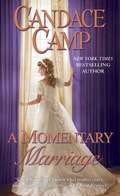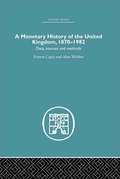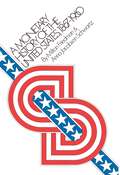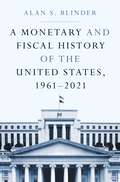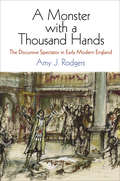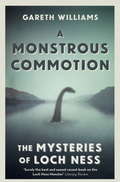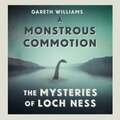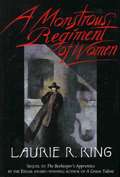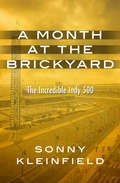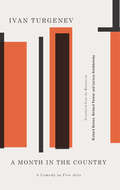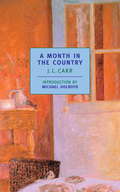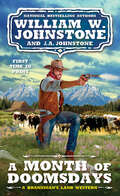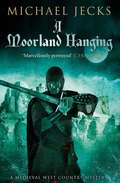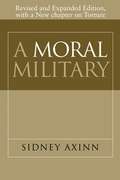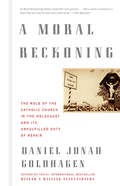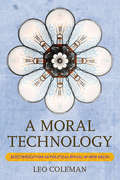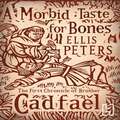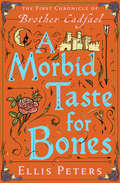- Table View
- List View
A Momentary Marriage
by Candace CampNew York Times bestselling author Candace Camp offers a delicious marriage-of-convenience story in this passionate historical romance, featuring her signature “clever and witty banter, sharp attention to detail, and utterly likable characters” (Publishers Weekly, starred review).James de Vere has always insisted on being perfectly pragmatic and rational in all things. It seemed the only way to deal with his overdramatic, greedy family. When he falls ill and no doctor in London can diagnose him, he returns home to Grace Hill in search of a physician who can—or to set his affairs in order. Arriving at the doctor’s home, he’s surprised to encounter the doctor's daughter Laura, a young woman he last saw when he was warning her off an attachment with his cousin Graeme. Alas, the doctor is recently deceased and Laura is closing up the estate, which must be sold off, leaving her penniless. At this, James has an inspiration: why not marry the damsel in distress? If his last hope for a cure is gone, at least he’ll have some companionship in his final days, and she’ll inherit his fortune instead of his grasping relatives, leaving her a wealthy widow with plenty of prospects. Laura is far from swept off her feet, but she’s as pragmatic as James, so she accepts his unusual proposal. But as the two of them brave the onslaught of shocked and suspicious family members, they find themselves growing closer. They vowed, “until death do us part”...but now both are longing for their marriage to be more than momentary in this evocative romance, perfect for fans of Sabrina Jeffries and Mary Balogh.
A Monetary History of the United Kingdom: 1870-1982
by Forrest Capie Alan WebberThis book is the culmination of a major research programme on the monetary history of the United Kingdom. This volume contains monetary series ranging from detailed balance sheet material to monetary aggregates such as M3 and are in monthly, quarterly and annual form. The data are drawn mostly from primary sources in the early part of the period and from more accessible published sources for more recent years. Critiques of existing series are given and assessments of the value of different sources are provided. The user should be able to build his/her own series from the basic constituents given here. This sources and assessment of data should be an essential reference to economic historians and applied economists with an interest and use to the students of money and banking and to monetary economists of other countries. This classic book was first published in 1985.
A Monetary History of the United States, 1867-1960 (National Bureau of Economic Research Publications #14)
by Milton Friedman Anna Jacobson SchwartzWriting in the June 1965 issue of theEconomic Journal, Harry G. Johnson begins with a sentence seemingly calibrated to the scale of the book he set himself to review: "The long-awaited monetary history of the United States by Friedman and Schwartz is in every sense of the term a monumental scholarly achievement--monumental in its sheer bulk, monumental in the definitiveness of its treatment of innumerable issues, large and small . . . monumental, above all, in the theoretical and statistical effort and ingenuity that have been brought to bear on the solution of complex and subtle economic issues." Friedman and Schwartz marshaled massive historical data and sharp analytics to support the claim that monetary policy--steady control of the money supply--matters profoundly in the management of the nation's economy, especially in navigating serious economic fluctuations. In their influential chapter 7, The Great Contraction--which Princeton published in 1965 as a separate paperback--they address the central economic event of the century, the Depression. According to Hugh Rockoff, writing in January 1965: "If Great Depressions could be prevented through timely actions by the monetary authority (or by a monetary rule), as Friedman and Schwartz had contended, then the case for market economies was measurably stronger." Milton Friedman won the Nobel Prize in Economics in 1976 for work related to A Monetary History as well as to his other Princeton University Press book, A Theory of the Consumption Function (1957).
A Monetary and Fiscal History of Latin America, 1960–2017
by Timothy J. Kehoe Juan Pablo NicoliniA major, new, and comprehensive look at six decades of macroeconomic policies across the region What went wrong with the economic development of Latin America over the past half-century? Along with periods of poor economic performance, the region&’s countries have been plagued by a wide variety of economic crises. This major new work brings together dozens of leading economists to explore the economic performance of the ten largest countries in South America and of Mexico. Together they advance the fundamental hypothesis that, despite different manifestations, these crises all have been the result of poorly designed or poorly implemented fiscal and monetary policies. Each country is treated in its own section of the book, with a lead chapter presenting a comprehensive database of the country&’s fiscal, monetary, and economic data from 1960 to 2017. The chapters are drawn from one-day academic conferences—hosted in all but one case, in the focus country—with participants including noted economists and former leading policy makers. Cowritten with Nobel Prize winner Thomas J. Sargent, the editors&’ introduction provides a conceptual framework for analyzing fiscal and monetary policy in countries around the world, particularly those less developed. A final chapter draws conclusions and suggests directions for further research.A vital resource for advanced undergraduate and graduate students of economics and for economic researchers and policy makers, A Monetary and Fiscal History of Latin America, 1960–2017 goes further than any book in stressing both the singularities and the similarities of the economic histories of Latin America&’s largest countries.Contributors: Mark Aguiar, Princeton U; Fernando Alvarez, U of Chicago; Manuel Amador, U of Minnesota; Joao Ayres, Inter-American Development Bank; Saki Bigio, UCLA; Luigi Bocola, Stanford U; Francisco J. Buera, Washington U, St. Louis; Guillermo Calvo, Columbia U; Rodrigo Caputo, U of Santiago; Roberto Chang, Rutgers U; Carlos Javier Charotti, Central Bank of Paraguay; Simón Cueva, TNK Economics; Julián P. Díaz, Loyola U Chicago; Sebastian Edwards, UCLA; Carlos Esquivel, Rutgers U; Eduardo Fernández Arias, Peking U; Carlos Fernández Valdovinos (former Central Bank of Paraguay); Arturo José Galindo, Banco de la República, Colombia; Márcio Garcia, PUC-Rio; Felipe González Soley, U of Southampton; Diogo Guillen, PUC-Rio; Lars Peter Hansen, U of Chicago; Patrick Kehoe, Stanford U; Carlos Gustavo Machicado Salas, Bolivian Catholic U; Joaquín Marandino, U Torcuato Di Tella; Alberto Martin, U Pompeu Fabra; Cesar Martinelli, George Mason U; Felipe Meza, Instituto Tecnológico Autónomo de México; Pablo Andrés Neumeyer, U Torcuato Di Tella; Gabriel Oddone, U de la República; Daniel Osorio, Banco de la República; José Peres Cajías, U of Barcelona; David Perez-Reyna, U de los Andes; Fabrizio Perri, Minneapolis Fed; Andrew Powell, Inter-American Development Bank; Diego Restuccia, U of Toronto; Diego Saravia, U de los Andes; Thomas J. Sargent, New York U; José A. Scheinkman, Columbia U; Teresa Ter-Minassian (formerly IMF); Marco Vega, Pontificia U Católica del Perú; Carlos Végh, Johns Hopkins U; François R. Velde, Chicago Fed; Alejandro Werner, IMF.
A Monetary and Fiscal History of the United States, 1961–2021
by Alan S. BlinderFrom the New York Times bestselling author, the fascinating story of U.S. economic policy from Kennedy to Biden—filled with lessons for todayIn this book, Alan Blinder, one of the world’s most influential economists and one of the field’s best writers, draws on his deep firsthand experience to provide an authoritative account of sixty years of monetary and fiscal policy in the United States. Spanning twelve presidents, from John F. Kennedy to Joe Biden, and eight Federal Reserve chairs, from William McChesney Martin to Jerome Powell, this is an insider’s story of macroeconomic policy that hasn’t been told before—one that is a pleasure to read, and as interesting as it is important.Focusing on the most significant developments and long-term changes, Blinder traces the highs and lows of monetary and fiscal policy, which have by turns cooperated and clashed through many recessions and several long booms over the past six decades. From the fiscal policy of Kennedy’s New Frontier to Biden’s responses to the pandemic, the book takes readers through the stagflation of the 1970s, the conquest of inflation under Jimmy Carter and Paul Volcker, the rise of Reaganomics, and the bubbles of the 2000s before bringing the story up through recent events—including the financial crisis, the Great Recession, and monetary policy during COVID-19.A lively and concise narrative that is sure to become a classic, A Monetary and Fiscal History of the United States, 1961–2021 is filled with vital lessons for anyone who wants to better understand where the economy has been—and where it might be headed.
A Monk Swimming: A Memoir
by Malachy McCourtIn this &“irresistible memoir that&’s equal parts pathos and belly laughs,&” the Irish American writer and actor shares stories from his first decade in the US (People). Malachy McCourt left behind a childhood of poverty and painful memories of his father and mother in Limerick, Ireland, when he followed his brother, Frank, to America in 1952. In A Monk Swimming, McCourt recounts the decade that followed. With not much to his name other than his sharp wit and knack for storytelling, McCourt was unsure what he would do after arriving in New York City. He worked as a longshoreman on the Brooklyn docks, became the first celebrity bartender in a Manhattan saloon, performed on stage with the Irish Players, and told tales to Jack Paar on The Tonight Show. Although McCourt gained success, money, women, and, eventually, children of his own, he still carried memories of the past with him. So, he fled again. He found himself in the Manhattan Detention Complex, otherwise known as the Tombs. He was arrested several times: poolside in Beverly Hills, in Zurich with gold-smugglers, and again in Calcutta with sex workers. McCourt&’s journey also took him to Paris, Rome, and even Limerick again, until finally he was forced to grapple with his past. &“[A] funny, oddly winning book.&” —The New York Times &“A rollicking good read that, as the Irish say, would make a dead man laugh.&” —The Philadelphia Inquirer &“A triumphant tale. . . . You will find yourself laughing through the tears.&” —Newsday &“Howlingly funny.&” —Atlanta Journal-Constitution &“Build[s] on the story of the McCourts&’ early life so dazzlingly told in Angela&’s Ashes by his brother Frank.&” —Thomas Keneally, author of the international bestseller Schindler&’s List
A Monster with a Thousand Hands: The Discursive Spectator in Early Modern England
by Amy J. RodgersA Monster with a Thousand Hands makes visible a figure that has been largely overlooked in early modern scholarship on theater and audiences: the discursive spectator, an entity distinct from the actual bodies attending early modern English playhouses. Amy J. Rodgers demonstrates how the English commercial theater's rapid development and prosperity altered the lexicon for describing theatergoers and the processes of engagement that the theater was believed to cultivate. In turn, these changes influenced and produced a cultural projection—the spectator—a figure generated by social practices rather than a faithful recording of those who attended the theater. The early modern discursive spectator did not merely develop alongside the phenomenological one, but played as significant a role in shaping early modern viewers and viewing practices as did changes to staging technologies, exhibition practices, and generic experimentation.While audience and film studies have theorized the spectator, these fields tend to focus on the role of twentieth-century media (film, television, and the computer) in producing mass-culture viewers. Such emphases lead to a misapprehension that the discursive spectator is modernity's creature. Fearing anachronism, early modern scholars have preferred demographic studies of audiences to theoretical engagements with the "effects" of spectatorship. While demographic work provides an invaluable snapshot, it cannot account for the ways that the spectator is as much an idea as a material presence. And, while a few studies pursue the dynamics that existed among author, text, and audience using critical tools sharpened by film studies, they tend to obscure how early modern culture understood the spectator. Rather than relying exclusively on historical or theoretical methodologies, A Monster with a Thousand Hands reframes spectatorship as a subject of inquiry shaped both by changes in entertainment technologies and the interaction of groups and individuals with different forms of cultural production.
A Monstrous Commotion: The Mysteries of Loch Ness
by Gareth WilliamsThe Loch Ness Monster: a creature that should have died out with the dinosaurs, or a legend built on hoaxes and wishful thinking?Sir Peter Scott, internationally renowned naturalist and president of the World Wildlife Fund, was convinced that the Monster existed. So were senior scientists at London's Natural History Museum and Chicago University; they lost their jobs because they refused to renounce their belief in the creature. For decades, the scientific establishment was determined to quash attempts to investigate Loch Ness - until Nature, the world's greatest research journal, published an article by Peter Scott featuring underwater photographs of the Monster. Drawing extensively on new material, Gareth Williams takes a wholly original look at what really happened in Loch Ness. A Monstrous Commotion tells the story as never before: a gripping saga populated by colourful characters who do extraordinary things in pursuit of one of evolution's wildest cards.Meticulously researched and dazzlingly written, this book will appeal to anyone fascinated by nature and its mysteries - and to everyone who enjoys a beautifully crafted detective story with a strong cast of heroes and villains, plenty of twists and an unexpected ending.
A Monstrous Commotion: The Mysteries of Loch Ness
by Gareth WilliamsThe Loch Ness Monster: a creature that should have died out with the dinosaurs, or a legend built on hoaxes and wishful thinking?Sir Peter Scott, internationally renowned naturalist and president of the World Wildlife Fund, was convinced that the Monster existed. So were senior scientists at London's Natural History Museum and Chicago University; they lost their jobs because they refused to renounce their belief in the creature. For decades, the scientific establishment was determined to quash attempts to investigate Loch Ness - until Nature, the world's greatest research journal, published an article by Peter Scott featuring underwater photographs of the Monster. Drawing extensively on new material, Gareth Williams takes a wholly original look at what really happened in Loch Ness. A Monstrous Commotion tells the story as never before: a gripping saga populated by colourful characters who do extraordinary things in pursuit of one of evolution's wildest cards.Meticulously researched and dazzlingly written, this book will appeal to anyone fascinated by nature and its mysteries - and to everyone who enjoys a beautifully crafted detective story with a strong cast of heroes and villains, plenty of twists and an unexpected ending.
A Monstrous Commotion: The Mysteries of Loch Ness
by Gareth WilliamsThe Loch Ness Monster: a creature that should have died out with the dinosaurs, or a legend built on hoaxes and wishful thinking?Sir Peter Scott, internationally renowned naturalist and president of the World Wildlife Fund, was convinced that the Monster existed. So were senior scientists at London's Natural History Museum and Chicago University; they lost their jobs because they refused to renounce their belief in the creature. For decades, the scientific establishment was determined to quash attempts to investigate Loch Ness - until Nature, the world's greatest research journal, published an article by Peter Scott featuring underwater photographs of the Monster. Drawing extensively on new material, Gareth Williams takes a wholly original look at what really happened in Loch Ness. A Monstrous Commotion tells the story as never before: a gripping saga populated by colourful characters who do extraordinary things in pursuit of one of evolution's wildest cards.Meticulously researched and dazzlingly written, this book will appeal to anyone fascinated by nature and its mysteries - and to everyone who enjoys a beautifully crafted detective story with a strong cast of heroes and villains, plenty of twists and an unexpected ending.Read by Andrew Cullum,with a postscript read by the author.(p) 2016 Orion Publishing Group
A Monstrous Regiment of Women (Mary Russell #2)
by Laurie R. KingSecond book featuring Sherlock Holmes and his apprentice Mary Russell. Russel has inherited wealth enough so she need not work. Yet she chooses to investigate the deaths of four people who die after changing their wills.
A Month at the Brickyard: The Incredible Indy 500
by Sonny KleinfieldAn all-access pass to Pit Row and beyond at the world&’s most famous auto race, the Indianapolis 500The Indianapolis 500 auto race is the most prestigious event in all of motor sports. Race cars roar two hundred times around the track at dizzying speeds of more than two hundred miles per hour in front of a massive crowd—and millions more watching on television. Every spring, drivers, teams, sponsors, and pit crews all come together to make auto-racing history. Since the inaugural race in 1911, the Indy 500 has become one of the most popular sporting events in the world.Award-winning reporter Sonny Kleinfield takes readers inside the world of high-risk, high-speed open-wheel racing. A Month at the Brickyard follows the day-to-day race prep of Indy up-and-comer Johnny Parsons and team, showing the endless fine-tuning and customization up to the big day, as well as capturing the personalities and stories that surround the speedway. With Kleinfield at the wheel, there is much more to racing than just the roar of the engines.
A Month in the Country
by Larissa Volokhonsky Richard Pevear Ivan Turgenev Richard Nelson"Pevear and Volokhonsky are at once scrupulous translators and vivid stylists of English."-The New YorkerOne week before her thirtieth birthday, the simple life of dutiful wife and mother Natalya is upended when the arrival of her son's charming new tutor unleashes a whirlwind of love, lust, and jealousy. This revelatory new translation by renowned playwright Richard Nelson along with Richard Pevear and Larissa Volokhonsky-the foremost contemporary translators of classic Russian literature, including the best-selling Oprah's Book Club selection, Anna Karenina-marks the second of a series of translations of important Russian plays to be published over the next ten years.Richard Nelson's many plays include Rodney's Wife, Goodnight Children Everywhere, Drama Desk-nominated Franny's Way and Some Americans Abroad, Tony Award-nominated Two Shakespearean Actors, and James Joyce's The Dead (with Shaun Davey), for which he won a Tony Award for Best Book of a Musical. His The Apple Family: Scenes from Life in the Country will be published by Theatre Communications Group in early 2014.Richard Pevear and Larissa Volokhonsky have produced acclaimed translations of Leo Tolstoy, Fyodor Dostoevsky, Nikolai Gogol, Anton Chekhov, and Mikhail Bulgakov. Their translations of The Brothers Karamazov and Anna Karenina won the 1991 and 2002 PEN/Book-of-the-Month Club Translation Prizes. Pevear, a native of Boston, and Volokhonsky, of St. Petersburg, are married to each other and live in Paris.
A Month in the Country
by Michael Holroyd J. L. CarrIn J. L. Carr's deeply charged poetic novel, Tom Birkin, a veteran of the Great War and a broken marriage, arrives in the remote Yorkshire village of Oxgodby where he is to restore a recently discovered medieval mural in the local church. Living in the bell tower, surrounded by the resplendent countryside of high summer, and laboring each day to uncover an anonymous painter's depiction of the apocalypse, Birkin finds that he himself has been restored to a new, and hopeful, attachment to life. But summer ends, and with the work done, Birkin must leave. Now, long after, as he reflects on the passage of time and the power of art, he finds in his memories some consolation for all that has been lost.
A Month of Doomsdays (A Brannigan's Land Western #3)
by William W. Johnstone J.A. JohnstoneThe national bestselling western authors William W. Johnstone and J.A. Johnstone bring us another Ty Brannigan western with a unique and American brand of justice. JOHNSTONE COUNTRY. TIME TO KILL. Former lawman Ty Brannigan tries to rope in some skittish cattle rustlers at his family ranch—and uncovers a nest of scheming bank robbers. Looks like he&’s going to need a bigger rope . . . DOOMSDAY IS COMING. Something fishy is going on with the beef at Circle P. After a quick-and-dirty shootout with a small band of rustlers, Ty Brannigan and his son Matt do another count of their cattle—and find they have fifty heads more than before. Seems the rustlers were hiding stolen cows from other ranches among the Brannigan herd. And that&’s just the tip of the cowpie. In jail, the rustlers rat out their partners to the local marshal. They&’re not just stealing cattle. They&’re plotting the biggest bank robbery in the county&’s bullet-riddled history. And this time, they&’re going to make a real killing. . . . Months in the planning—and just days away—the countdown to doomsday has begun. Ty, Matt, and the town marshall must race against time to track down the robbers before they strike—or innocent people will die. But the Brannigans aren&’t afraid of danger. When the clock runs out—and the shooting starts—every man&’s days are numbered . . . Live Free. Read Hard.
A Monument to Dynasty and Death: The Story of Rome's Colosseum and the Emperors Who Built It (Witness to Ancient History)
by Nathan T. ElkinsGo behind the scenes to discover why the Colosseum was the king of amphitheaters in the Roman world—a paragon of Roman engineering prowess.Early one morning in 80 CE, the Colosseum roared to life with the deafening cheers of tens of thousands of spectators as the emperor, Titus, inaugurated the new amphitheater with one hundred days of bloody spectacles. These games were much anticipated, for the new amphitheater had been under construction for a decade. Home to spectacles involving exotic beasts, elaborate executions of criminals, gladiatorial combats, and even—when flooded—small-scale naval battles, the building itself was also a marvel. Rising to a height of approximately 15 stories and occupying an area of 6 acres—more than four times the size of a modern football field—the Colosseum was the largest of all amphitheaters in the Roman Empire. In A Monument to Dynasty and Death, Nathan T. Elkins tells the story of the Colosseum's construction under Vespasian, its dedication under Titus, and further enhancements added under Domitian. The Colosseum, Elkins argues, was far more than a lavish entertainment venue: it was an ideologically charged monument to the new dynasty, its aspirations, and its achievements. A Monument to Dynasty and Death takes readers on a behind-the-scenes tour of the Colosseum from the subterranean tunnels, where elevators and cages transported gladiators and animals to the blood-soaked arena floor, to the imperial viewing box, to the amphitheater's decoration and amenities, such as fountains and an awning to shade spectators. Trained as an archaeologist, an art historian, and a historian of ancient Rome, Elkins deploys an interdisciplinary approach that draws on contemporary historical texts, inscriptions, archaeology, and visual evidence to convey the layered ideological messages communicated by the Colosseum. This engaging book is an excellent resource for classes on Roman art, architecture, history, civilization, and sport and spectacle.
A Monument to the End of Time: Alchemy, Fulcanelli and the Great Cross
by Jay Weidner Vincent BridgesA history of Sufi Moslem Christian and Judiasm and how the mystries of alchemy have weaved its way through all of them still only showing glimces of its truth. The authur explores the Cross at Henda France and the mystries the Fulcanelli revealed in the early 1920's in his writings.
A Moonless, Starless Sky: Ordinary Women and Men Fighting Extremism in Africa
by Alexis Okeowo"Absolutely essential reading, period."---Alexandra Fuller, bestselling author of Don't Let's Go to the Dogs Tonight In the tradition of Behind the Beautiful Forevers, this is a masterful, humane work of literary journalism by New Yorker staff writer Alexis Okeowo--a vivid narrative of Africans who are courageously resisting their continent's wave of fundamentalism.In A Moonless, Starless Sky Okeowo weaves together four narratives that form a powerful tapestry of modern Africa: a young couple, kidnap victims of Joseph Kony's LRA; a Mauritanian waging a lonely campaign against modern-day slavery; a women's basketball team flourishing amid war-torn Somalia; and a vigilante who takes up arms against the extremist group Boko Haram. This debut book by one of America's most acclaimed young journalists illuminates the inner lives of ordinary people doing the extraordinary--lives that are too often hidden, underreported, or ignored by the rest of the world.
A Moorland Hanging (Medieval West Country Mystery #3)
by Michael Jecks14th Century Devon: Peter Bruther flees his master, Sir William Beauscyr, in a time when to do so could earn him a brutal punishment. Having presented himself as a tin miner to the king, who gives him the status of a serf, he is safe from the claims of Sir William. But when Bruther's body is found hanging from a tree, Simon and Sir Baldwin must investigate a cold-blooded murder.
A Moral Military, Revised and Expanded Edition
by Sidney AxinnShould a good soldier ever disobey a direct military order? Are there restrictions on how we fight a war? What is meant by 'military honor', and does it really affect the contemporary soldier? Is human dignity possible under battlefield conditions? Sidney Axinn considers these basic ethical questions within the context of the laws of warfare and answers 'yes' to each of these questions. In this study of the conduct of war, he examines actions that are honorable or dishonorable and provides the first full-length treatment of the military conventions from a philosophical point of view. Axinn gives a philosophical analysis of the 'Laws of Warfare' as found in the Hague and Geneva Conventions, which have been agreed to by almost every nation in the world. The aims of his study are to establish a basic twentieth-century framework for moral military action and to assist military personnel in analyzing their won professional ethic.Stating that moral reasoning is required by people in military uniform in a wide variety of situations, the author examines the question of the limits of military obedience. Axinn argues for the seriousness of the concept of military honor but limits honorable military activity by a strict interpretation of the notion of war crime. Major chapters deal with military honor, prisoners of war, spying, war crimes, the dirty-hands theory of command, nuclear weapons, terrorism, and covert operations. This philosophical study of the line between honorable and dishonorable military action cautions that in compliance with the war conventions professional military personnel and knowledgeable civilians must not lose their moral nerve nor abandon honor to satisfy immoral political requests. Author note: Sidney Axinn is Professor of Philosophy at Temple University.
A Moral Reckoning: The Role of the Church in the Holocaust and Its Unfulfilled Duty of Repair
by Daniel Jonah GoldhagenWith his first book,Hitler's Willing Executioners, Daniel Jonah Goldhagen dramatically revised our understanding of the role ordinary Germans played in the Holocaust. Now he brings his formidable powers of research and argument to bear on the Catholic Church and its complicity in the destruction of European Jewry. What emerges is a work that goes far beyond the familiar inquiries--most of which focus solely on Pope Pius XII--to address an entire history of hatred and persecution that culminated, in some cases, in an active participation in mass-murder. More than a chronicle,A Moral Reckoningis also an assessment of culpability and a bold attempt at defining what actions the Church must take to repair the harm it did to Jews--and to repair itself. Impressive in its scholarship, rigorous in its ethical focus, the result is a book of lasting importance.
A Moral Technology: Electrification as Political Ritual in New Delhi
by Leo ColemanIn India over the past century, electrification has meant many things: it has been a colonial gift of modern technology, a tool of national integration and political communication, and a means of gauging the country's participation in globalization. Electric lights have marked out places of power, and massive infrastructures have been installed in hopes of realizing political promises. In A Moral Technology, the grids and wires of an urban public utility are revealed to be not only material goods but also objects of intense moral concern. Leo Coleman offers a distinctive anthropological approach to electrification in New Delhi as more than just an economic or industrial process, or a "gridding" of social and political relations. It may be understood instead as a ritual action that has formed modern urban communities and people’s sense of citizenship, and structured debates over state power and political legitimacy.Coleman explores three historical and ethnographic case studies from the founding of New Delhi as an imperial capital city, to its reshaping as a national capital for post-independence India, up to its recent emergence as a contemporary global city. These case studies closely describe technological politics, rituals, and legal reforms at key moments of political change in India, and together they support Coleman’s argument that ritual performances, moral judgments, and technological installations combine to shape modern state power, civic life, and political community.
A Morbid Taste For Bones: 1 (Cadfael Chronicles #1)
by Ellis PetersIn 1137 the ambitious head of Shrewsbury Abbey has decided to acquire the remains of Saint Winifred for his Benedictine order. Brother Cadfael is part of the expedition sent to her final resting place in Wales, where they find the villagers passionately divided by the Benedictines' offer for the saint's relics.Canny, wise and all too worldly, Cadfael isn't surprised when this taste for bones leads to bloody murder. The leading opponent to moving the grave has been shot dead with a mysterious arrow, and some say Winifred herself dealt the blow. Brother Cadfael knows that a carnal hand did the killings, but he doesn't know that his plan to unearth a murderer may dig up a case of love and justice, where the wages of sin may be scandal - or his own ruin.
A Morbid Taste for Bones (The Chronicles of Brother Cadfael #1)
by Ellis PetersThe &“irresistible&” and &“compelling&” first novel in the historical mystery series featuring a Welsh Benedictine monk in the twelfth century (The Washington Post). A Welsh Benedictine monk living at Shrewsbury Abbey in western England, Brother Cadfael spends much of his time tending the herbs and vegetables in the garden—but now there&’s a more pressing matter. Cadfael is to serve as translator for a group of monks heading to the town of Gwytherin in Wales. The team&’s goal is to collect the holy remains of Saint Winifred, which Prior Robert hopes will boost the abbey&’s reputation, as well as his own. But when the monks arrive in Gwytherin, the town is divided over the request. When the leading opponent to disturbing the grave is found shot dead with a mysterious arrow, some believe Saint Winifred herself delivered the deadly blow. Brother Cadfael knows an earthly hand did the deed, but his plan to root out a murderer may dig up more than he can handle. Before CSI and Law & Order, there was Brother Cadfael, &“wily veteran of the Crusades&” (Los Angeles Times). His knowledge of herbalism, picked up in the Holy Land, and his skillful observance of human nature are blessings in dire situations, and earned Ellis Peters a Crime Writers&’ Association Silver Dagger Award. A Morbid Taste for Bones kicks off a long-running and much-loved series that went on to be adapted for stage, radio, and television.
A More Beautiful and Terrible History: The Uses and Misuses of Civil Rights History
by Jeanne TheoharisExplodes the fables that have been created about the civil rights movementThe civil rights movement has become national legend, lauded by presidents from Reagan to Obama to Trump, as proof of the power of American democracy. This fable, featuring dreamy heroes and accidental heroines, has shuttered the movement firmly in the past, whitewashed the forces that stood in its way, and diminished its scope. And it is used perniciously in our own times to chastise present-day movements and obscure contemporary injustice.In A More Beautiful and Terrible History award-winning historian Jeanne Theoharis dissects this national myth-making, teasing apart the accepted stories to show them in a strikingly different light. We see Rosa Parks not simply as a bus lady but a lifelong criminal justice activist and radical; Martin Luther King, Jr. as not only challenging Southern sheriffs but Northern liberals, too; and Coretta Scott King not only as a "helpmate" but a lifelong economic justice and peace activist who pushed her husband's activism in these directions. Moving from "the histories we get" to "the histories we need," Theoharis challenges nine key aspects of the fable to reveal the diversity of people, especially women and young people, who led the movement; the work and disruption it took; the role of the media and "polite racism" in maintaining injustice; and the immense barriers and repression activists faced. Theoharis makes us reckon with the fact that far from being acceptable, passive or unified, the civil rights movement was unpopular, disruptive, and courageously persevering. Activists embraced an expansive vision of justice--which a majority of Americans opposed and which the federal government feared. By showing us the complex reality of the movement, the power of its organizing, and the beauty and scope of the vision, Theoharis proves that there was nothing natural or inevitable about the progress that occurred. A More Beautiful and Terrible History will change our historical frame, revealing the richness of our civil rights legacy, the uncomfortable mirror it holds to the nation, and the crucial work that remains to be done.
